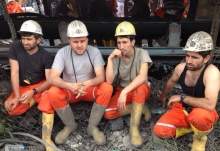

Understanding geology and material science is one of the more challenging, but utterly fundamental, processes of mine management and planning. And although mining today, particularly in Western countries, is considered safer than ever, mine collapse does still happen.

Discover B2B Marketing That Performs
Combine business intelligence and editorial excellence to reach engaged professionals across 36 leading media platforms.
This is because it is still very difficult to accurately predict the effect a natural disaster or failure in infrastructure might have on a mine site – making such predictions as accurately as possible is the difference between life and death.
This is a field Dr Giang Nguyen, a senior lecturer at the School of Civil, Environmental and Mining Engineering at the University of Adelaide, Australia, is particularly interested in, and from January 2015 will dedicate the next four years studying.
In order to predict material behaviour failure scientists will often use small-scale laboratory tests and analysis to project what might happen on a larger scale.
Through his research Dr Nguyen, a civil engineer by trade, intends to come up with a method for better prediction that can link failures at micro, specimen and large field scales to create simple practical formulas to be easily adopted by any engineer working in material structures, including mines.

US Tariffs are shifting - will you react or anticipate?
Don’t let policy changes catch you off guard. Stay proactive with real-time data and expert analysis.
By GlobalDataHeidi Vella-Starr (HVS): What are the scenarios you will be looking at for testing material failure?
Dr Giang Nguyen (GN): In the development of material models, we usually have to cover a range of loading scenarios, for example, tension, isotropic compression, triaxial compression under high/low pressure and under different strain rates and temperatures. This is to give the material models the predictive capability in different cases that follow real situations.
HVS: Which materials will you be concentrating on?
Could an international safety regime help bring automation into wider use in the industry?
GN: The main focus is geomaterials, for example, soils, rocks, but others, such as concrete and composites, will also be under investigation under the same modelling framework. In short, we’ll develop a framework for material modelling that can cover a range of different behaviour in soils, rocks and concrete. Then, depending on the material, further specialisation will be applied.
HVS: Can you explain in more detail what the computational models will look like?
GN: There will be two parts of a computational model: the material behaviour (given by material models) and numerical methods (e.g. finite element method) to model the structures – mines, dams. The project focuses on the development of new material models. Once done, these models will be implemented in numerical methods for the simulation or prediction of failure of real structures.
HVS: What are the challenges in scaling up?
GN: There is too much information at the lower scales and incorporating all of them in the computation at the larger scales is impossible and also not necessary. The challenge is to understand, select and embed only essential information, in terms of some lower-scale failure mechanisms, in the material model. This is all about the balance between accuracy (e.g. by adding more lower-scale details) and efficiency (e.g. keeping only essential details to reduce the computational cost). This is called constitutive modelling, and it is in my opinion both an art and a science.
HVS: What are the major challenges of turning theoretical modelling into practical models?
GN: To me it’s like another balance between accuracy and efficiency. Computational simulation using theoretical models requires powerful computers, and is time-consuming, but can give good results in terms of accuracy. A practical model is the opposite, when accuracy is traded with efficiency, for example, a few seconds for a less accurate answer.
HVS: What do you find most exciting about the field of materials science, and material failure in particular?
GN: Besides the understanding of material failure, it is the question on how to use this understanding in predicting failure. In this sense, I am interested in transforming this understanding to something predictive.
HVS: How has your experience in civil engineering prepared you for the task ahead?
GN: I just follow my interest and try to do things that are exciting to me. In this process I’ve learnt a lot and see lots of connections between what I’ve learned at school and universities, from different perspectives. And that just keeps pushing me.


.gif)



